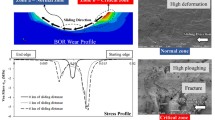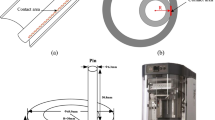Abstract
Arc-soft-toe bracket (ASTB), as a joint structure in the marine structure, is the hot spot with significant stress concentration, therefore, fatigue behavior of ASTBs is an important point of concern in their design. Since macroscopic geometric factors obviously influence the stress flaws in joints, the shapes and sizes of ASTBs should represent the stress distribution around cracks in the hot spots. In this paper, we introduce a geometric magnification factor for reflecting the macroscopic geometric effects of ASTB crack features and construct a 3D finite element model to simulate the distribution of stress intensity factor (SIF) at the crack endings. Sensitivity analyses with respect to the geometric ratio H t /L b , R/L b , L t /L b are performed, and the relations between the geometric factor and these parameters are presented. A set of parametric equations with respect to the geometric magnification factor is obtained using a curve fitting technique. A nonlinear relationship exists between the SIF and the ratio of ASTB arm to toe length. When the ratio of ASTB arm to toe length reaches a marginal value, the SIF of crack at the ASTB toe is not influenced by ASTB geometric parameters. In addition, the arc shape of the ASTB slope edge can transform the stress flowing path, which significantly affects the SIF at the ASTB toe. A proper method to reduce stress concentration is setting a slope edge arc size equal to the ASTB arm length.
Similar content being viewed by others
References
Bowness, D., and Lee, M. M., 2000. Prediction of weld toe magnification factors for semi-elliptical cracks in T-butt joint. International Journal of Fatigue, 22: 369–387.
BS7910, 1999. Guide on methods for assessing the acceptability of flaws in metallic structures. British Standard Institute.
Han, J. W., Lee, K. H., and Han, S. H., 2012. Three-dimensional weld toe magnification factors for various welded joints. Journal of Mechanical Science and Technology, 26: 2121–2124.
Han, Y., and Huang, X. P., 2006. The simplified calculation method of stress intensity factors of surface cracks in T-butt joint. Ship Building of China, 1: 1–11.
Jang, B. S., Ito, H., and Kim, K. S., 2010. A study of fatigue crack propagation at a web stiffener on a longitudinal stiffener. Journal of Marine Science Technology, 15: 176–189.
Lie, S. T., Zhao, H. S., and Vipin, S. P., 2016. New weld toe magnification factors for semi-elliptical cracks in plate-to-plate butt-welded joints. Fatigue & Fracture of Engineering Materials & Structures, 40: 207–220.
Liu, G. J., Zhong, B. L., Tiana, X. J., Chen, P. F., and Mu, W. L., 2016. Numerical analysis on the HSS and SIF of multi-planar DX-joint welds for offshore platforms. Ocean Engineering, 127: 258–268.
Newman, J. C., and Raju, I. S., 1981. An empirical stress-intensity factor equation for the surface crack. Engineering Fracture Mechanics, 15: 185–192.
Pang, H. L., Hoh, H. J., Tsang, K. S., Low, J., Kong, S. C., and Yuan, W. G., 2017. Fatigue crack propagation analysis for multiple weld toe cracks in cut-out fatigue test specimens from a girth welded pipe. International Journal of Fatigue, 94: 158–165.
Pang, H. L., Tsang, K. S., and Hoh, H. J., 2016. 3D stress intensity factors for weld toe semi-elliptical surface cracks using XFEM. Marine Structures, 48: 1–14.
Wang, C., and Huang, Y., 2004. Study on stress distribution of the joint caused by detailed configuration. Ship Building of China, 45: 112–119.
Wu, R. F., and Huang, X. P., 2012. Prediction of crack growth of surface crack at bracket toe of ship under random wave loading condition. Journal of Ship Mechanics, 16: 549–556.
Yan, R. J., Hang, H. M., and Xin, C., 2016. Study on stress intensity factor of T-joint weld toe under biaxial compressive loads. Journal of Wuhan University of Technology (Transportation Science & Engineering), 40 (4): 574–579 (in Chinese with English abstract).
Acknowledgements
This work was supported by the National Natural Science Foundation of China (NSFC) (Nos. 51490675 and 11572300), the Natural Science Foundation of Shandong Province (NSFSD) (No. ZR2015EM025), and the Fundamental Research Fund for Central Universities (Ocean University of China).
Author information
Authors and Affiliations
Corresponding author
Rights and permissions
About this article
Cite this article
Fu, Q., Li, H., Wang, H. et al. Fatigue Magnification Factors of Arc-Soft-Toe Bracket Joints. J. Ocean Univ. China 17, 527–534 (2018). https://doi.org/10.1007/s11802-018-3374-4
Received:
Revised:
Accepted:
Published:
Issue Date:
DOI: https://doi.org/10.1007/s11802-018-3374-4




